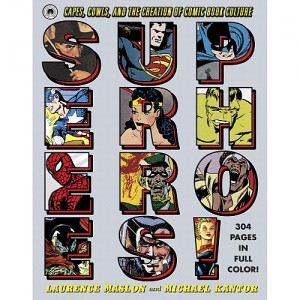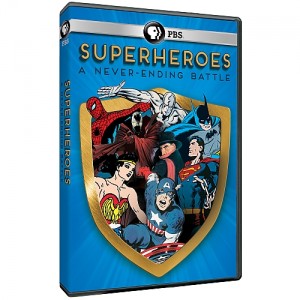 I got this book as a Christmas gift. It’s a beautiful work, developed as a companion to the PBS film (which I’ve not seen) Superheroes – A Never-Ending Battle. It’s chock-full of gorgeous shots of comic covers, comic artists at work, rough sketches and unfinished pages of famous characters, and photos of many of the actors who brought superheroes to life on screens big and small. It does a wonderful job of chronicling the genesis of a genre, starting with the pulp magazines which date back to the turn of the 20th Century, and including insights on the industry and the people who made it that I’ve never come across before. That says something, because I have read a lot about comics history.
I got this book as a Christmas gift. It’s a beautiful work, developed as a companion to the PBS film (which I’ve not seen) Superheroes – A Never-Ending Battle. It’s chock-full of gorgeous shots of comic covers, comic artists at work, rough sketches and unfinished pages of famous characters, and photos of many of the actors who brought superheroes to life on screens big and small. It does a wonderful job of chronicling the genesis of a genre, starting with the pulp magazines which date back to the turn of the 20th Century, and including insights on the industry and the people who made it that I’ve never come across before. That says something, because I have read a lot about comics history.
 The narrative moves sorta chronologically, jumping from company to company and often stopping to highlight a particularly big event, like, say the creation of Superman. Somewhere around the dawn of the Silver Age (arguably 1955, when Barry Allen made his debut as the Flash in Showcase #4), it moves from being an high-altitude overview of the industry and becomes more of a recounting of the bits the authors thought (or had been told) were important. There are holes in the research, errors in the details, in the latter half of the book, showing clearly that someone who hasn’t actually read the books in question is trying to talk about them. Most of all, some important creators like Chris Claremont and John Byrne get little coverage, while eccentric comic-haters like Grant Morrison are covered in depth, and influential talents like Steve Englehart and Matt Wagner are not mentioned at all.
The narrative moves sorta chronologically, jumping from company to company and often stopping to highlight a particularly big event, like, say the creation of Superman. Somewhere around the dawn of the Silver Age (arguably 1955, when Barry Allen made his debut as the Flash in Showcase #4), it moves from being an high-altitude overview of the industry and becomes more of a recounting of the bits the authors thought (or had been told) were important. There are holes in the research, errors in the details, in the latter half of the book, showing clearly that someone who hasn’t actually read the books in question is trying to talk about them. Most of all, some important creators like Chris Claremont and John Byrne get little coverage, while eccentric comic-haters like Grant Morrison are covered in depth, and influential talents like Steve Englehart and Matt Wagner are not mentioned at all.
For the unenlightened, Claremont essentially created the New X-Men with Dave Cockrum in 1975. Tehcnically, Len Wein was the writer who created Wolverine, Colossus, Storm and Nightcrawler; but Dave Cockrum had actually created the visuals on most of the characters years earlier, and Wein only wrote their first appearance. It was Claremont and Cockrum who, using a combination of old and new characters, turned Marvel’s worst selling book of the Silver Age into its most valuable property for decades to come. John Byrne, who replaced Cockrum two years in, brought the book to new heights of popularity with his clear, fluid style and his obvious synchronicity with Claremont.
Steve Englehart invented the multi-book “Summer Event” when he penned the Avengers/Defenders War in 1973. The authors credit Marv Wolfman and George Perez, who created Crisis on Infinite Earths 12 years later, with this accomplishment. Englehart also was behind the “Secret Empire” storyline in Captain America which re-defined the character for the age of Watergate. (It looks like it will also contribute a lot of plot elements to the upcoming film.)
Matt Wagner created Grendel, the celebrated story of a not-so-nice masked vigilante which obviously informed later works like The Dark Knight and was one of Dark Horse Comics’ early successes. He also was behind 80-plus issues of
Sandman Mystery Theatre, a noir comic which breathed new life into one of DC Comics’ oldest masked heroes. He may have been snubbed because the authors thought the original 1939 Sandman was a boring character, never mind the fact that he inspired giants like Joe Simon, Jack Kirby and Neil Gaiman.
But the next-to-last chapter had a title so off-the-wall that it made me go “Huh?” and prompted me to comment here. The title is “Heroes we can believe in again,” and it’s a chapter about Marvel Comics in the 21st Century, specifically, it’s about Marvel Comics after the advent of a line-wide “event” called Civil War. Civil War was one of those ripped-from-the-headlines storylines that comics publishers are always so proud of doing, even though they never (ever) fail to pound their readers senseless with their preachiness and lack of subtlety. In this one, some young heroes make an error in judgment while trying to stop a super-villain, and they wind up destroying a town, killing its inhabitants. In the fictional universe of Marvel, this causes an outcry for super-powered people to register themselves with the Federal Government, and reveal their secret identities. The heroes of the Marvel Universe line up on opposite sides of the issue (their choices have no bearing whatsoever on their previously established personality traits) and start fighting. In the end, the side of government regulation wins, the side of freedom loses. Iron Man becomes the (extremely fascist) czar of Homeland Security, and Captain America goes to jail and then dies.
The authors dub this, “the end of grim and gritty comics,” meaning fifteen or so years about anti-heroes who mostly kill people were over. The rationale behind that proclamation is that a woman in the crowd when Cap is arrested, the mother of one of the slain from the cataclysm which kicked off the story, tells Iron Man that he’s given the public heroes they can believe in again. And so, suddenly, we’re supposed to say that there is no longer moral relativism in comics, that everything is bright and sunny, and superheroes stand only for good. Um… because… a multi-millionaire industrialist alcoholic hounded his best friend, a member of the Greatest Generation to his grave? In exactly what are the citizens of the Marvel Universe (or the readers) supposed to believe, exactly? The idea that might makes right? The idea that, whatever the government says, you just need to give into it, and as long as you do, you’ll be okay?
It all comes down, for me, to a question I’ve discussed before: what is a hero?
There’s the Arthur Ashe definition: “True heroism is remarkably sober, very undramatic. It is not the urge to surpass all others at whatever cost, but the urge to serve others at whatever cost.”
There’s the Ayn Rand definition: A “being, with his own happiness as the moral purpose of his life, with productive achievement his noblest activity, and reason as his only absolute.”
There’s the Stan Lee definition: Someone with great power and thus great responsibility.
I guess only Ashe’s definition fits the kind of hero Iron Man has become by the end of Civil War, because he really does believe he’s serving the greater good. But I’ve said often that I don’t accept self-sacrifice as the defining standard of heroism. A hero has to stand for something. He has to put personal gain and convenience aside, yes, but he has to do it because there is an absolute that he knows is right. I guess you could cram Iron Man’s actions in Civil War into that definition, so I’ll throw in another caveat: “And ye harm none, do as ye will.” You can be dead right, but if you hurt others, you’re still wrong. That’s what’s missing, for me, from this definition of “Heroes we can believe in again.”
And maybe that’s why I’m so out of touch with most comics, and most mass entertainment in 2014. I do need heroes I can believe in, and I have to be able to believe that they’re somehow better than the shmoe on the street. Marvel, and most modern comics publishers, have excelled at delivering realistic characters, but not heroic ones, for more than a decade. They’re believable. But I don’t think that means you can believe in them.
In the end, maybe the problem is that I generally don’t accept things the way they are. I usually know they can be better. I hope I work to make them better. I need my heroes to do the same.
I do recommend this book. It’s beautiful and it’s got a lot of good information. The fact that the final chapters, well, honestly, depressed me has a lot less to do with the book than it does with the state of popular culture and popular morality. But maybe that’s just me…
